SNOSA56I February 2003 – September 2015 LMV7271 , LMV7272 , LMV7275
PRODUCTION DATA.
- 1 Features
- 2 Applications
- 3 Description
- 4 Revision History
- 5 Pin Configuration and Functions
-
6 Specifications
- 6.1 Absolute Maximum Ratings
- 6.2 ESD Ratings
- 6.3 Recommended Operating Conditions
- 6.4 Thermal Information
- 6.5 1.8-V Electrical Characteristics
- 6.6 1.8-V AC Electrical Characteristics
- 6.7 2.7-V Electrical Characteristics
- 6.8 2.7-V AC Electrical Characteristics
- 6.9 5-V Electrical Characteristics
- 6.10 5-V AC Electrical Characteristics
- 6.11 Typical Characteristics
-
7 Detailed Description
- 7.1 Overview
- 7.2 Functional Block Diagram
- 7.3 Feature Description
- 7.4 Device Functional Modes
- 8 Application and Implementation
- 9 Power Supply Recommendations
- 10Layout
- 11Device and Documentation Support
- 12Mechanical, Packaging, and Orderable Information
Package Options
Mechanical Data (Package|Pins)
Thermal pad, mechanical data (Package|Pins)
Orderable Information
6 Specifications
6.1 Absolute Maximum Ratings (1)(2)
| MIN | MAX | UNIT | ||
|---|---|---|---|---|
| VIN Differential | ±Supply Voltage | V | ||
| Supply Voltage (V+ - V−) | 6 | V | ||
| Voltage at Input/Output pins | (V+) + 0.1 | (V−) − 0.1 | V | |
| Junction Temperature(3) | 150 | °C | ||
| Storage Temperature, Tstg | –65 | 150 | °C | |
(1) Stresses beyond those listed under Absolute Maximum Ratings may cause permanent damage to the device. These are stress ratings only, which do not imply functional operation of the device at these or any other conditions beyond those indicated under Recommended Operating Conditions. Exposure to absolute-maximum-rated conditions for extended periods may affect device reliability.
(2) If Military/Aerospace specified devices are required, please contact the Texas Instruments Sales Office / Distributors for availability and specifications.
(3) The maximum power dissipation is a function of TJ(MAX), RθJA, and TA. The maximum allowable power dissipation at any ambient temperature is PD = (TJ(MAX) - TA)/RθJA. All numbers apply for packages soldered directly into a PCB.
6.2 ESD Ratings
| VALUE | UNIT | |||
|---|---|---|---|---|
| SOT-23, SC70 PACKAGE | ||||
| V(ESD) | Electrostatic discharge | Human body model (HBM), per ANSI/ESDA/JEDEC JS-001(1)(2) | ±2000 | V |
| Machine Model (MM)(3) | ±200 | |||
| DSBGA PACKAGE | ||||
| V(ESD) | Electrostatic discharge | Human body model (HBM), per ANSI/ESDA/JEDEC JS-001(1)(2) | ±2000 | V |
| Machine Model (MM)(3) | ±200 | |||
(1) JEDEC document JEP155 states that 500-V HBM allows safe manufacturing with a standard ESD control process.
(2) Human body model, 1.5 kΩ in series with 100 pF.
(3) Machine Model, 0 Ω in series with 200 pF.
6.3 Recommended Operating Conditions
| MIN | MAX | UNIT | |
|---|---|---|---|
| Supply Voltage | 1.8 | 5.5 | V |
| Temperature(1) | –40 | 85 | °C |
(1) The maximum power dissipation is a function of TJ(MAX), RθJA, and TA. The maximum allowable power dissipation at any ambient temperature is PD = (TJ(MAX) - TA)/RθJA. All numbers apply for packages soldered directly into a PCB.
6.4 Thermal Information
| THERMAL METRIC(1) | LMV7271, LMV7275 | LMV7272 | UNIT | ||
|---|---|---|---|---|---|
| DBV (SOT-23) | DGK (SC70) | YZR (DSBGA) | |||
| 5 PINS | 5 PINS | 8 PINS | |||
| RθJA | Junction-to-ambient thermal resistance(2) | 325 | 265 | 220 | °C/W |
(1) For more information about traditional and new thermal metrics, see the Semiconductor and IC Package Thermal Metrics application report, SPRA953.
(2) The maximum power dissipation is a function of TJ(MAX), RθJA, and TA. The maximum allowable power dissipation at any ambient temperature is PD = (TJ(MAX) - TA)/RθJA. All numbers apply for packages soldered directly into a PCB.
6.5 1.8-V Electrical Characteristics
Unless otherwise specified, all limits ensured for TJ = 25°C, V+ = 1.8 V, V− = 0 V.| PARAMETER | CONDITION | MIN(2) | TYP(1) | MAX(2) | UNIT | ||
|---|---|---|---|---|---|---|---|
| VOS | Input Offset Voltage | 0.3 | 4 | mV | |||
| At the temperature extremes | 6 | ||||||
| TC VOS | Input Offset Temperature Drift | VCM = 0.9 V (3) | 20 | uV/°C | |||
| IB | Input Bias Current | 10 | nA | ||||
| IOS | Input Offset Current | 200 | pA | ||||
| IS | Supply Current | LMV7271/LMV7275 | 9 | 12 | µA | ||
| At the temperature extremes | 14 | ||||||
| LMV7272 | 18 | 25 | µA | ||||
| At the temperature extremes | 28 | ||||||
| ISC | Output Short Circuit Current | Sourcing, VO = 0.9 V (LMV7271/LMV7272 only) |
3.5 | 6 | mA | ||
| Sinking, VO = 0.9 V | 4 | 6 | |||||
| VOH | Output Voltage High (LMV7271/LMV7272 only) |
IO = 0.5 mA | 1.7 | 1.74 | V | ||
| IO = 1.5 mA | 1.47 | 1.63 | |||||
| VOL | Output Voltage Low | IO = −0.5 mA | 52 | 100 | mV | ||
| IO = −1.5 mA | 166 | 220 | |||||
| VCM | Input Common-Mode Voltage Range | CMRR > 45 dB | 1.9 | V | |||
| −0.1 | V | ||||||
| CMRR | Common-Mode Rejection Ratio | 0 < VCM < 1.8 V | 46 | 78 | dB | ||
| PSRR | Power Supply Rejection Ratio | V+ = 1.8 V to 5 V | 55 | 80 | dB | ||
| ILEAKAGE | Output Leakage Current | VO = 1.8 V (LMV7275 only) | 2 | pA | |||
(1) Typical values represent the most likely parametric norm.
(2) All limits are ensured by testing or statistical analysis.
(3) Offset Voltage average drift determined by dividing the change in VOS at temperature extremes into the total temperature change.
6.6 1.8-V AC Electrical Characteristics
Unless otherwise specified, all limits ensured for TJ = 25°C, V+ = 1.8 V, V− = 0 V, VCM = 0.5 V, VO = V+/2 and RL > 1 MΩ to V−.| PARAMETER | CONDITION | MIN(2) | TYP(1) | MAX(2) | UNIT | |
|---|---|---|---|---|---|---|
| tPHL | Propagation Delay (High to Low) |
Input Overdrive = 20 mV Load = 50 pF//5 kΩ |
880 | ns | ||
| Input Overdrive = 50 mV Load = 50 pF//5 kΩ |
570 | ns | ||||
| tPLH | Propagation Delay (Low to High) |
Input Overdrive = 20 mV Load = 50 pF//5 kΩ |
1100 | ns | ||
| Input Overdrive = 50 mV Load = 50 pF//5 kΩ |
800 | ns | ||||
(1) Typical values represent the most likely parametric norm.
(2) All limits are ensured by testing or statistical analysis.
6.7 2.7-V Electrical Characteristics
Unless otherwise specified, all limits ensured for TJ = 25°C, V+ = 2.7 V, V− = 0 V.| PARAMETER | CONDITIONS | MIN(2) | TYP(1) | MAX(2) | UNIT | ||
|---|---|---|---|---|---|---|---|
| VOS | Input Offset Voltage | 0.3 | 4 | mV | |||
| At the temperature extremes | 6 | ||||||
| TC VOS | Input Offset Temperature Drift | VCM = 1.35 V(3) | 20 | µV/°C | |||
| IB | Input Bias Current | 10 | nA | ||||
| IOS | Input offset Current | 200 | pA | ||||
| IS | Supply Current | LMV7271/LMV7275 | 9 | 13 | µA | ||
| At the temperature extremes | 15 | ||||||
| LMV7272 | 18 | 25 | µA | ||||
| At the temperature extremes | 28 | ||||||
| ISC | Output Short Circuit Current | Sourcing, VO = 1.35 V (LMV7271/LMV7272 only) |
10 | 15 | mA | ||
| Sinking, VO = 1.35 V | 10 | 15 | |||||
| VOH | Output Voltage High (LMV7271/LMV7272 only) |
IO = 0.5 mA | 2.63 | 2.66 | V | ||
| IO = 2.0 mA | 2.48 | 2.55 | |||||
| VOL | Output Voltage Low | IO = −0.5 mA | 50 | 70 | mV | ||
| IO = −2 mA | 155 | 220 | |||||
| VCM | Input Common Voltage Range | CMRR > 45 dB | 2.8 | V | |||
| −0.1 | V | ||||||
| CMRR | Common-Mode Rejection Ratio | 0 < VCM < 2.7 V | 46 | 78 | dB | ||
| PSRR | Power Supply Rejection Ratio | V+ = 1.8 V to 5 V | 55 | 80 | dB | ||
| ILEAKAGE | Output Leakage Current | VO = 2.7 V (LMV7275 only) | 2 | pA | |||
(1) Typical values represent the most likely parametric norm.
(2) All limits are ensured by testing or statistical analysis.
(3) Offset Voltage average drift determined by dividing the change in VOS at temperature extremes into the total temperature change.
6.8 2.7-V AC Electrical Characteristics
Unless otherwise specified, all limits ensured for TJ = 25°C, V+ = 2.7 V, V− = 0 V, VCM = 0.5 V, VO = V+/2 and RL > 1 MΩ to V−.| PARAMETER | CONDITION | MIN(2) | TYP(1) | MAX(2) | UNIT | |
|---|---|---|---|---|---|---|
| tPHL | Propagation Delay (High to Low) |
Input Overdrive = 20 mV Load = 50 pF//5 kΩ |
1200 | ns | ||
| Input Overdrive = 50 mV Load = 50 pF//5 kΩ |
810 | ns | ||||
| tPLH | Propagation Delay (Low to High) |
Input Overdrive = 20 mV Load = 50 pF//5 kΩ |
1300 | ns | ||
| Input Overdrive = 50 mV Load = 50 pF//5 kΩ |
860 | ns | ||||
(1) Typical values represent the most likely parametric norm.
(2) All limits are ensured by testing or statistical analysis.
6.9 5-V Electrical Characteristics
Unless otherwise specified, all limits ensured for TJ = 25°C, V+ = 5 V, V− = 0 V.| PARAMETER | CONDITIONS | MIN(2) | TYP(1) | MAX(2) | UNIT | ||
|---|---|---|---|---|---|---|---|
| VOS | Input Offset Voltage | 0.3 | 4 | mV | |||
| At the temperature extremes | 6 | ||||||
| TC VOS | Input Offset Temperature Drift | VCM = 2.5 V(3) | 20 | µV/°C | |||
| IB | Input Bias Current | 10 | nA | ||||
| IOS | Input Offset Current | 200 | pA | ||||
| IS | Supply Current | LMV7271/LMV7275 | 10 | 14 | µA | ||
| At the temperature extremes | 16 | ||||||
| LMV7272 | 20 | 27 | µA | ||||
| At the temperature extremes | 30 | ||||||
| ISC | Output Short Circuit Current | Sourcing, VO = 2.5 V (LMV7271/LMV7272 only) |
18 | 34 | mA | ||
| Sinking, VO = 2.5 V | 18 | 34 | |||||
| VOH | Output Voltage High (LMV7271/LMV7272 only) |
IO = 0.5 mA | 4.93 | 4.96 | V | ||
| IO = 4.0 mA | 4.675 | 4.77 | |||||
| VOL | Output Voltage Low | IO = −0.5 mA | 27 | 70 | mV | ||
| IO = −4.0 mA | 225 | 315 | |||||
| VCM | Input Common Voltage Range | CMRR > 45 dB | 5.1 | V | |||
| −0.1 | |||||||
| CMRR | Common-Mode Rejection Ratio | 0 < VCM < 5.0 V | 46 | 78 | dB | ||
| PRSS | Power Supply Rejection Ratio | V+ = 1.8 V to 5 V | 55 | 80 | dB | ||
| ILEAKAGE | Output Leakage Current | VO = 5 V (LMV7275 only) | 2 | pA | |||
(1) Typical values represent the most likely parametric norm.
(2) All limits are ensured by testing or statistical analysis.
(3) Offset Voltage average drift determined by dividing the change in VOS at temperature extremes into the total temperature change.
6.10 5-V AC Electrical Characteristics
Unless otherwise specified, all limits ensured for TJ = 25°C, V+ = 5.0 V, V− = 0 V, VCM = 0.5 V, VO = V+/2 and RL > 1 MΩ to V−.| PARAMETER | CONDITION | MIN(2) | TYP(1) | MAX(2) | UNIT | |
|---|---|---|---|---|---|---|
| tPHL | Propagation Delay (High to Low) |
Input Overdrive = 20 mV Load = 50 pF//5 kΩ |
2100 | ns | ||
| Input Overdrive = 50 mV Load = 50 pF//5 kΩ |
1380 | ns | ||||
| tPLH | Propagation Delay (Low to High) |
Input Overdrive = 20 mV Load = 50 pF//5 kΩ |
1800 | ns | ||
| Input Overdrive = 50 mV Load = 50 pF//5 kΩ |
1100 | ns | ||||
(1) Typical values represent the most likely parametric norm.
(2) All limits are ensured by testing or statistical analysis.
6.11 Typical Characteristics
TA = 25°C, Unless otherwise specified.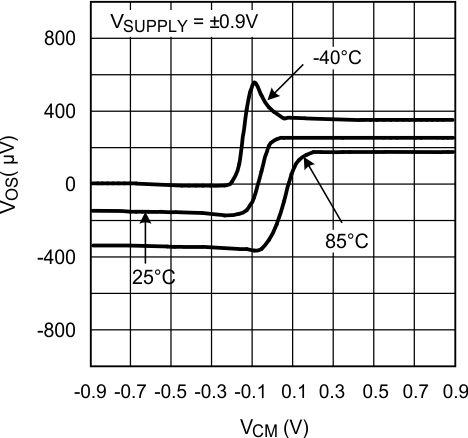 Figure 1. VOS vs. VCM
Figure 1. VOS vs. VCM
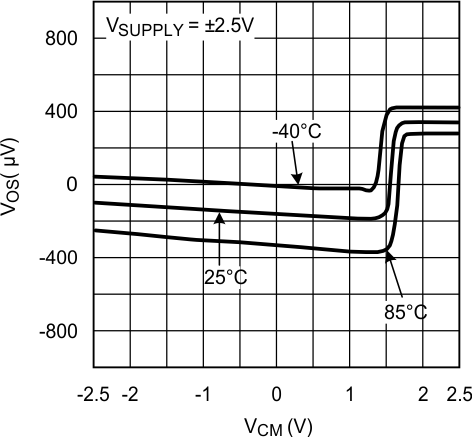 Figure 3. VOS vs. VCM
Figure 3. VOS vs. VCM
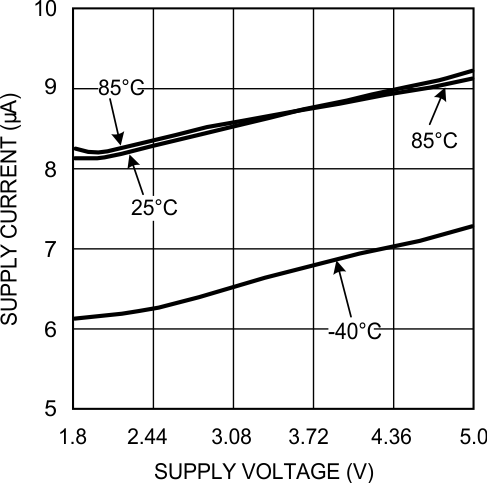 Figure 5. Supply Current vs. Supply Voltage (LMV7271)
Figure 5. Supply Current vs. Supply Voltage (LMV7271)
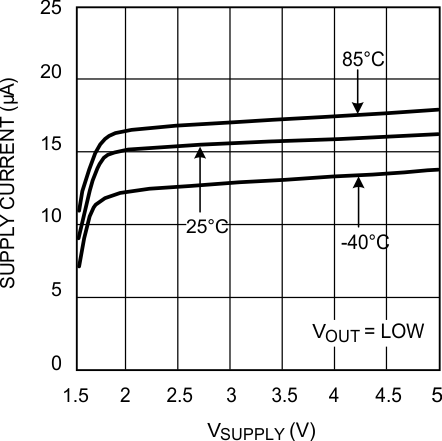 Figure 7. Supply Current vs. Supply Voltage (LMV7272)
Figure 7. Supply Current vs. Supply Voltage (LMV7272)
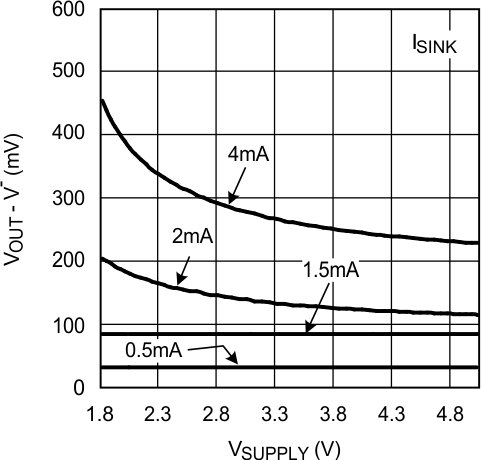 Figure 9. Output Negative Swing vs. VSUPPLY
Figure 9. Output Negative Swing vs. VSUPPLY
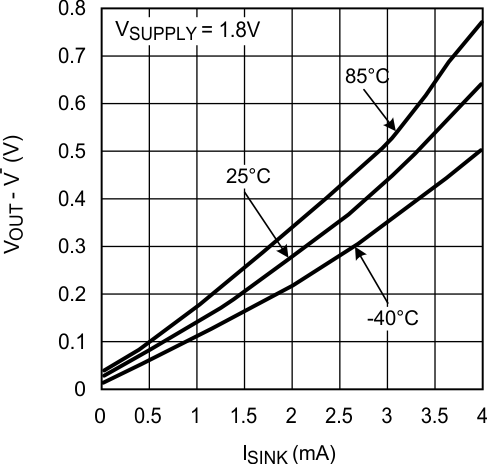 Figure 11. Output Negative Swing vs. ISINK
Figure 11. Output Negative Swing vs. ISINK
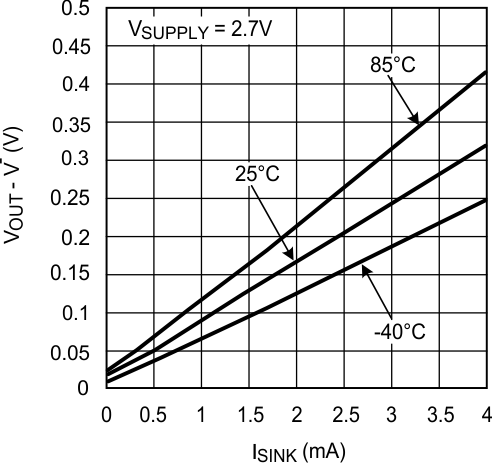 Figure 13. Output Negative Swing vs. ISINK
Figure 13. Output Negative Swing vs. ISINK
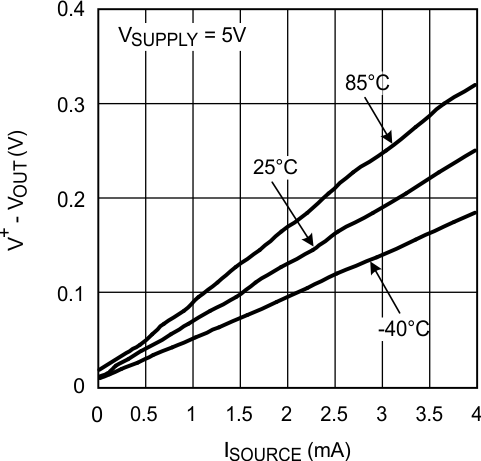 Figure 15. Output Positive Swing vs. ISOURCE
Figure 15. Output Positive Swing vs. ISOURCE
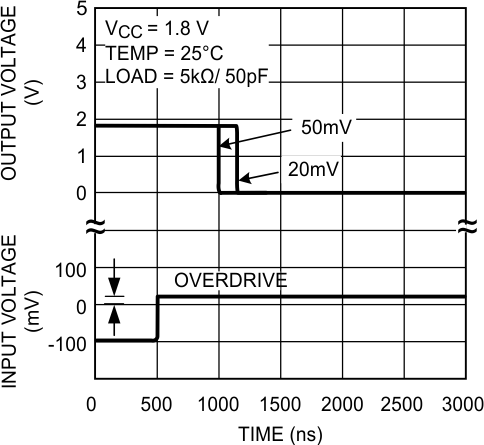 Figure 17. Propagation Delay (tPHL)
Figure 17. Propagation Delay (tPHL)
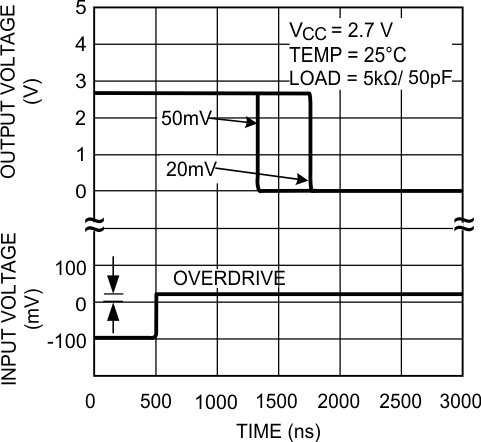 Figure 19. Propagation Delay (tPHL)
Figure 19. Propagation Delay (tPHL)
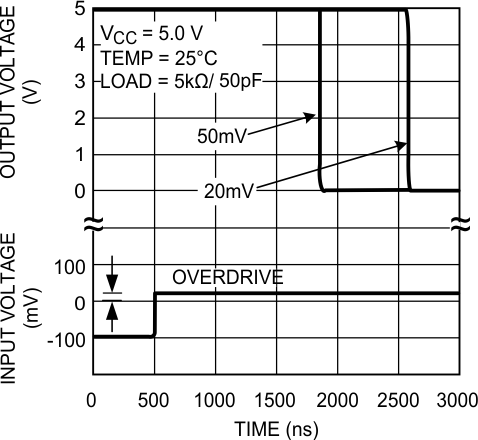 Figure 21. Propagation Delay (tPHL)
Figure 21. Propagation Delay (tPHL)
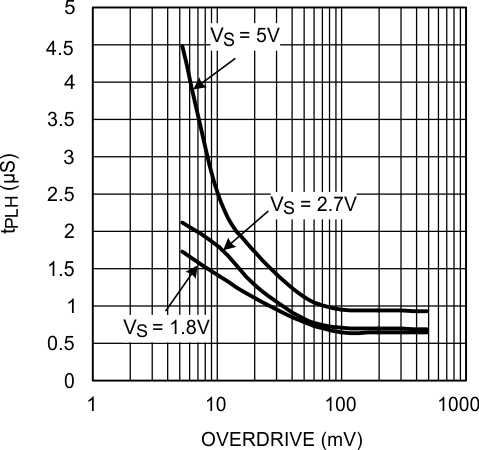 Figure 23. tPLH vs. Overdrive
Figure 23. tPLH vs. Overdrive
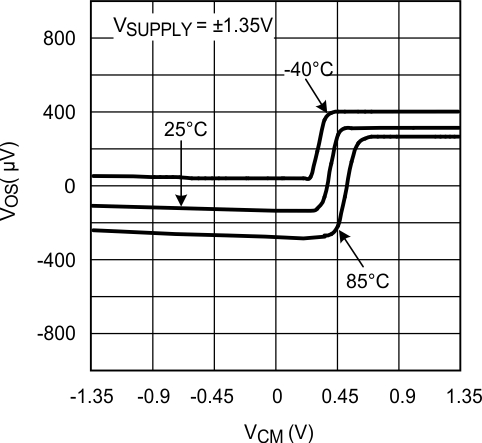 Figure 2. VOS vs. VCM
Figure 2. VOS vs. VCM
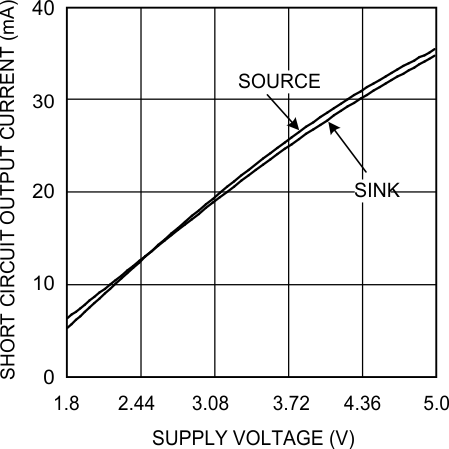 Figure 4. Short Circuit vs. Supply Voltage
Figure 4. Short Circuit vs. Supply Voltage
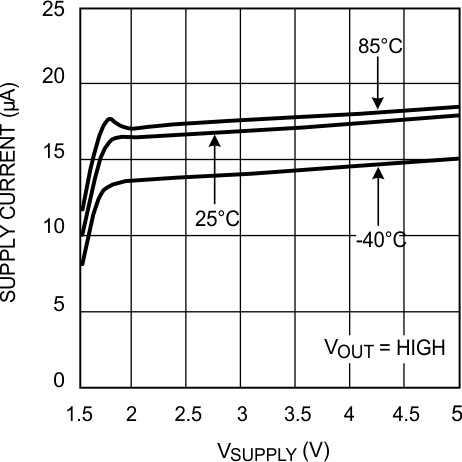 Figure 6. Supply Current vs. Supply Voltage (LMV7272)
Figure 6. Supply Current vs. Supply Voltage (LMV7272)
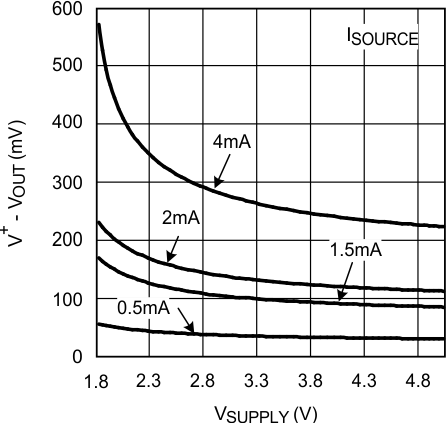 Figure 8. Output Positive Swing vs. VSUPPLY
Figure 8. Output Positive Swing vs. VSUPPLY
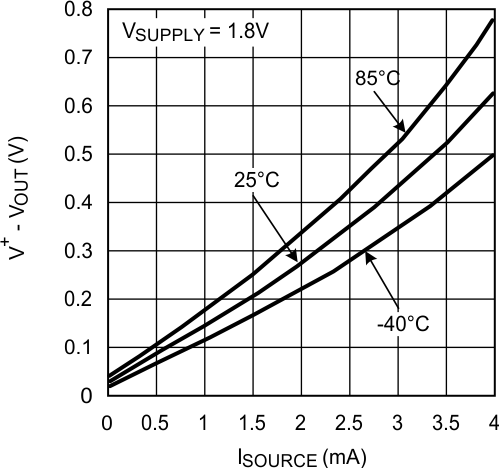 Figure 10. Output Positive Swing vs. ISOURCE
Figure 10. Output Positive Swing vs. ISOURCE
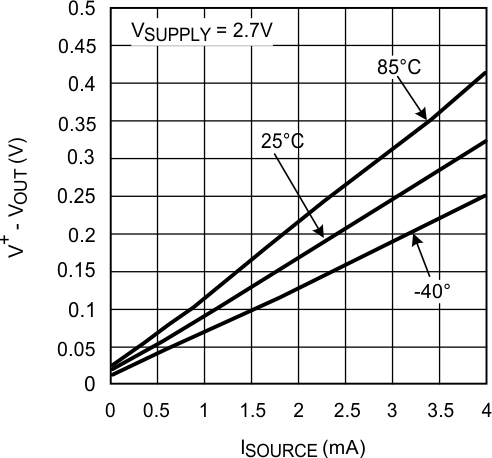 Figure 12. Output Positive Swing vs. ISOURCE
Figure 12. Output Positive Swing vs. ISOURCE
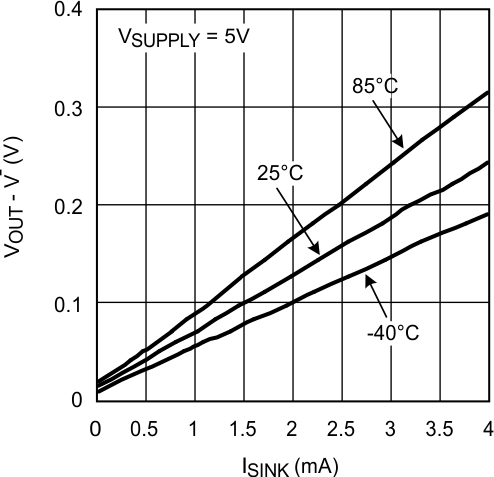 Figure 14. Output Negative Swing vs. ISINK
Figure 14. Output Negative Swing vs. ISINK
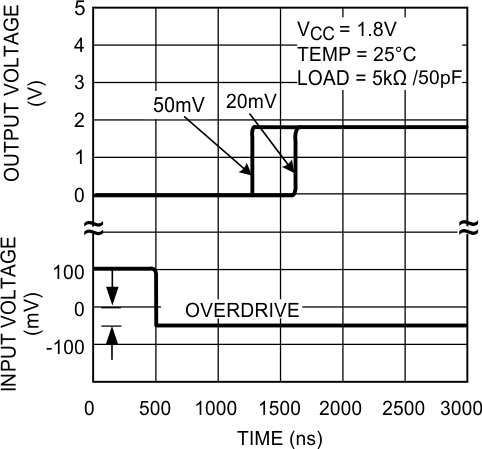 Figure 16. Propagation Delay (tPLH)
Figure 16. Propagation Delay (tPLH)
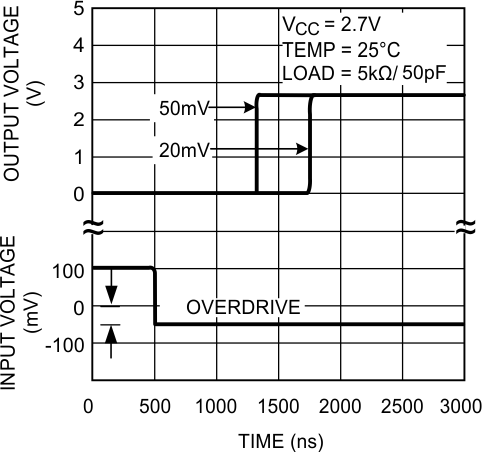 Figure 18. Propagation Delay (tPLH)
Figure 18. Propagation Delay (tPLH)
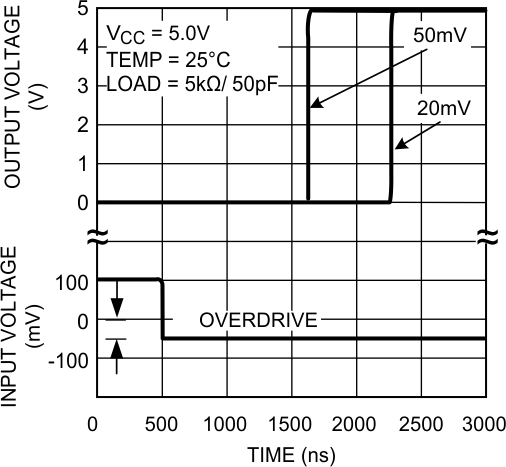 Figure 20. Propagation Delay (tPLH)
Figure 20. Propagation Delay (tPLH)
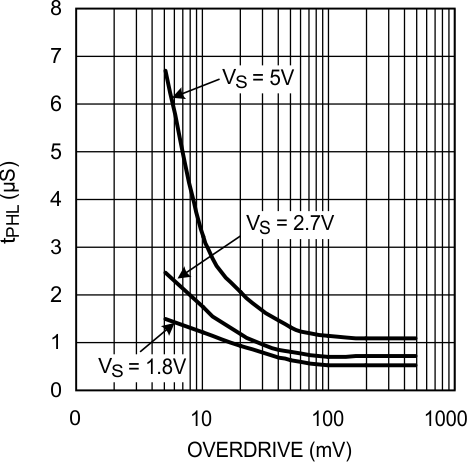 Figure 22. tPHL vs. Overdrive
Figure 22. tPHL vs. Overdrive